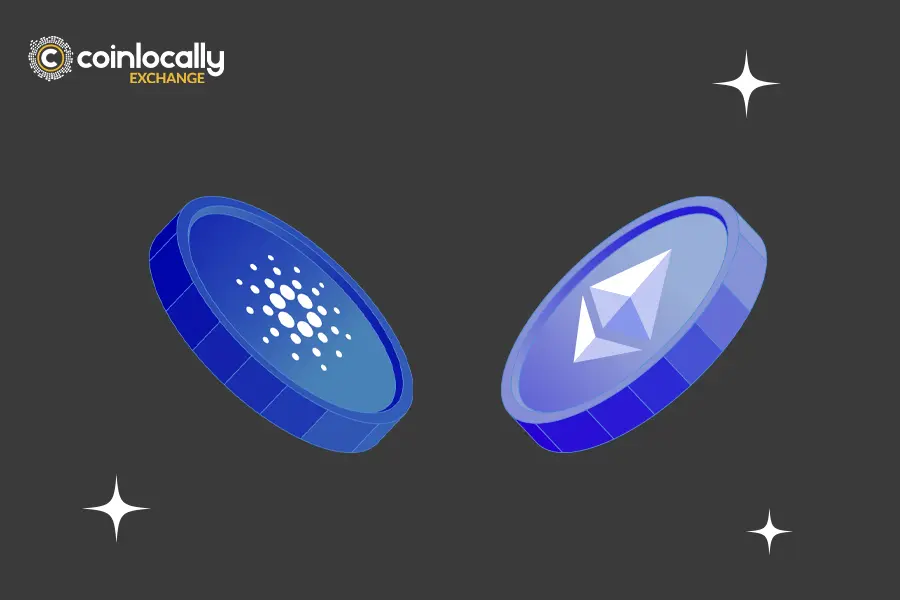Crypto liquid staking is one of the secrets of making passive income without sacrificing liquidity. You only need to stake the assets without locking them up and enjoy the rewards accumulating in your wallet. Keep scrolling to learn more about liquid staking and find the best coins with the highest rewards.
Table of Contents
What Is Staking?
In simple terms, staking is holding your crypto assets in a blockchain wallet for a set period to help the blockchain activities and earn rewards for your participation.
Staking allows you to join a Proof-of-Stake (PoS) platform’s consensus mechanism, put your funds to work, and help the blockchain network carry out certain activities. Doing so entitles you to passive income or staking rewards.
The PoS mechanism, i.e., proving your contribution to the network by staking your crypto tokens, was designed as an alternative to the Proof-of-Work (PoW) model, where contributors showed participation by validating transactions and adding them to the blockchain.
Staking comes in various forms, and the following section helps us understand their differences.
What are the Different Types of Liquid Staking Crypto?
Depending on the blockchain specifications and its consensus mechanisms, staking can be categorized into three main types: Validator (Hard), Cold (Offline), and Liquid (Soft), which we’ll go through here.
- Validator (Hard) Staking: Many PoS networks use this type of staking called Validator (Hard) Staking. In this type of staking, the stakes are called validators, as they hold and lock up a specific amount of their crypto assets in a set wallet to help validate transactions and add them to the blockchain.
Delegated staking is another form of validator staking, in which users delegate tokens to a third-party validator. This is better for those with less crypto knowledge, as they don’t have to run their validating node.
- Cold (Offline) Staking: In Cold or Offline staking, the stakeholders hold their assets in a cold wallet and let a staking pool handle the process.
- Liquid (Soft) Staking: Crypto liquid staking is the easiest type of staking, in which users stake their assets without locking them up. In the following section, we will discuss the details of liquid staking.
What Is Liquid Staking Crypto?
Many experts believe that crypto liquid staking is the most common and versatile form because it enables users to stake their assets and earn rewards while letting them trade the staked tokens.
This is the main feature that differentiates liquid staking from other types, which require the tokens to be locked up for specific time frames.
Crypto liquid staking can be part of
- Liquidity Pools, and
- Lending/ Borrowing Platforms.
Liquid Staking Crypto in Liquidity Pools
Liquidity pools are networks that provide liquidity (funds) for trading. Stakers can stake or deposit their assets in the pools as liquidity providers and receive a share of the transaction fees in return.
In the meantime, the stakeholders have access to their tokens and can trade them. This is possible because the stakeholders receive rewards based on the number of tokens they have staked and the staking period.
Liquid Staking Crypto in Lending/ Borrowing Platforms
Liquid staking is also a part of lending/ borrowing networks, where stakers work as lenders who provide funds for borrowers and receive interest for their participation. In this process, stakeholders can also access and trade their tokens.
Let’s get more technical and learn how crypto liquid staking works.
How Does Liquid Staking Crypto Work?
Crypto liquid staking works by letting the stakers stake their assets into a pool or platform, where their staked assets aid in supporting the network.
In return for participating in the network activities, the stakeholders are rewarded with a certain number of cryptocurrencies according to the staking period and the amount they have staked.
In the above sections, we mentioned different types of staking. Here, we’ll compare the two most common staking types: Liquid (Soft) and Validator (Hard).
Liquid Staking vs. Validator Staking
As mentioned earlier, both Liquid and Validator staking enable users to earn easy passive income by holding their cryptocurrencies in crypto wallets. But as you may know, they have similarities and differences; let’s examine them.
| Feature | Liquid Staking | Validator Staking |
| Required Holding | Requires holding native tokens | Requires holding native tokens |
| Reward Mechanism | Rewards for network participation | Rewards for network participation |
| Consensus Mechanism | Used in PoS networks | Used in PoS networks |
Similarities
- In both types of staking (Liquid and Validator), the stakers need to hold a certain number of the blockchain’s native tokens (i.e., the blockchain of the network they stake on).
- Both staking types reward the stakers for participating in the network and supporting it.
- Both Liquid and Validator staking types are applied in PoS networks.
Differences
| Feature | Liquid Staking | Validator Staking |
| Asset Accessibility | Stakers can access their assets | Stakers lock up their assets for a period |
| Participation Method | Deposit assets into a pool | Run a validator node |
| Security and Maintenance | A pool or a platform maintains security | The user retains the node |
| User Expertise | Beginner-friendly | Requires technical and financial knowledge |
Differences
- In Liquid staking, the stakers can access their staked assets, while in Validator staking, the stakers have to lock up their funds for specific time frames.
- In Liquid staking, the stakers deposit their assets in a pool or platform to earn rewards. In contrast, in Validators staking, stakers run a validator node to validate transactions and earn rewards.
- In Liquid staking, the pool or platform maintains the pool and secures the assets, but in Validator staking, the users need to keep the nodes and secure the assets.
- Liquid staking is easier to use and is better for beginners, but Validator staking needs more technical and financial knowledge and is used by more advanced users.
Overall, we can’t say one is better than the other, as each has advantages and disadvantages. You need to choose the one that best suits your purpose and preferences.
Although many consider liquid staking to be the easiest and best staking type, you need to know its pros and cons in detail to make an informed decision. Let’s see what they are.
Liquid Staking Crypto Pros and Cons
Liquid staking is favored by many for ease of use and accessibility of the staked tokens. Learning about the pros and cons of this staking type helps you make better crypto investment decisions.
Pros of Liquid Staking Crypto
Crypto liquid staking
- It’s more flexible and usable because it allows stakeholders to gain rewards while enabling them access to the staked assets.
- Adds to the liquidity stability of the crypto market by providing liquidity for DEXs and other networks.
- Offers more use cases like lending, borrowing, and governance.
- It is more suitable for beginners and less advanced users as it doesn’t require high levels of crypto technical knowledge.
Cons of Liquid Staking Crypto
- Liquid staking rewards are less than Validator staking.
- Stakers don’t have complete control over the pool’s assets and security, as the pool or the platform controls these matters.
- Networks and liquidity pools set a minimum deposit limit and have varying terms of service and fees that the stakes need to consider.
- Reward distribution and tracking are not transparent in liquid staking.
Now that you know all the basics of staking and liquid staking, it’s time to find some coins for staking. To help save you time, we’ve handpicked the best coins for liquid staking with the highest rewards. Keep scrolling!
The Best Coins For Liquid Staking With The Highest Rewards
The following table depicts the best coins for liquid staking with the highest staking rewards. Remember that
- Different platforms have varying fees, rules, and reward options, and rewards are awarded based on the number of tokens you stake and the staking period. Staking rewards change over time and with inflation.
In the section following the table, we’ll go through the best platforms for crypto liquid staking.
The Best Platforms For Liquid Staking
Because liquid staking is easy to use, various platforms offer it, but of course, with various fees and conditions.
The following table summarises the best platforms for crypto liquid staking. You should choose them based on your needs and preferences.
Now that we’re discussing the best platforms for liquid staking, let’s go through Polygon, Near, Cosmos, Osmosis, Ankr, Avalanche, Polkadot, and Fantom.
Liquid Staking Crypto: Polygon Liquid Staking
In fact, Polygon was designed to solve Ethereum’s scaling issue by using sidechains to maximize throughput and minimize fees on the Ethereum main chain.
Polygon provides a staking pool for users to deposit funds and add liquidity to earn staking rewards. Polygon rewards MATIC stakers with more MATIC tokens.
Stakers help secure the Polygon network and participate in governance activities in exchange for the funds they deposit.
Near Liquid Staking
Near aims to be a decentralized blockchain and a fast, less expensive, and scalable network for dApps (Decentralized Applications). In addition, it uses the Nightshade consensus mechanism, a form of PoS mechanism.
Participants need to stake NEAR tokens in the Near staking pool to help validate transactions and earn participation rewards, i.e., more NEAR tokens.
In addition to liquid staking, the Near protocol offers Delegate staking, which we explained in the early sections of this article.
Liquid Staking Crypto: Cosmos (ATOM) Liquid Staking
Cosmos was developed to improve interoperability between various blockchain networks. Its consensus mechanism is called “Tendermint BFT, ” a sister-like variant of the PoS model.
In the Cosmos ork, users can network’s nat—tok—ATOM to support blockchain activities and earn ATOM tokens as a reward.
Validator and delegated, and so offers governance rights to ATOM token holders.
Liquid Staking Crypto: Osmosis
Osmosis is a PoS decentralized and cross-chain AMM developing OSMO as its native token. This platform enables developers to build and deploy customized Osmosis uses inter-blockchain communication (IBC) to AMMs.
To provide cross-chain transactions (IBC), it allows speakers to deposit their tokens, provide liquidity, and swap the native tokens of the platforms supporting Tendermint IBC.
Osmosis provides superfluid staking, where stakeholders deposit their ame time and use it to provide liquidity for the Osmosis liquidity pool.
Liquid Staking Crypto: Ankr
As a Dets user, you can deploy and run customizable blockchains. Dets is a decentralized blockchain network with a consensus mechanism called Proof-of-Stake-on-Demand (PoSOD), another common form of the PoS mechanism.
ANKR is the native token of the Ankr network, which is staked and rewarded to the stakers.
Liquid Staking Crypto: Avalanche
As a decentralized blockchain, Avalanche enables its users to create and control various independent subnets in a larger network, i.e., virtual chains.
Avalanche utilizes the Avalanche-X consensus mechanism, a customized PoS mechanism.
Participants of the Avalanche platform can stake their AVAX tokens to support the network and earn staking rewards.
Polkadot (DOT) Liquid Staking
Another famous multi-chain platform is Polkadot (DOT), which enables transactions among blockchains. Its version of the PoS mechanism is called the NPoS consensus mechanism.
Polkadot lets its users stake its DOT tokens to participate in network activities, gain governance, and receive its plus staking rewards.
Fantom Liquid Staking
Fantom is another secure blockchain platform that offers liquid staking and strives to be a high-performance, modular platform. The Fantom network aims to mass-adopt dApps and provides fast and low-cost transactions to achieve this goal.
Its consensus mechanism is called Lachesis, a form of the Practical Byzantine Fault Tolerance (PBFT) mechanism.
To earn staking rewards on the platform, users must stake FTM tokens,, gain governance,, and contribute to the platform’s liquidity pool.
Summary of Liquid Staking Crypto
Liquid staking is an easy method of earning passive income favored by many crypto enthusiasts, both beginners and more advanced users.
Before choosing any token or platform for staking, you must research the investment risks. Although staking is known to be a less-risky crypto investment, it’s not risk-free, and fraud and hacking are two common dangers of cryptocurrency investments, among others.
FAQ on Liquid Staking Crypto
Read the following Q&As to find answers to any possible questions about crypto liquid staking.
What Is Soft Staking?
Soft staking or Liquid staking is the process of holding a certain number of cryptocurrencies in a network for a set period to provide funds for the liquidity pool and earn staking rewards in return. In soft staking, you can access your staked token, and there is no lock-up period.
What Is Validator Staking?
Validator staking is a more technical type of cryptocurrency that involves locking your tokens up on a platform for a certain timeframe to validate transactions and earn staking rewards.




